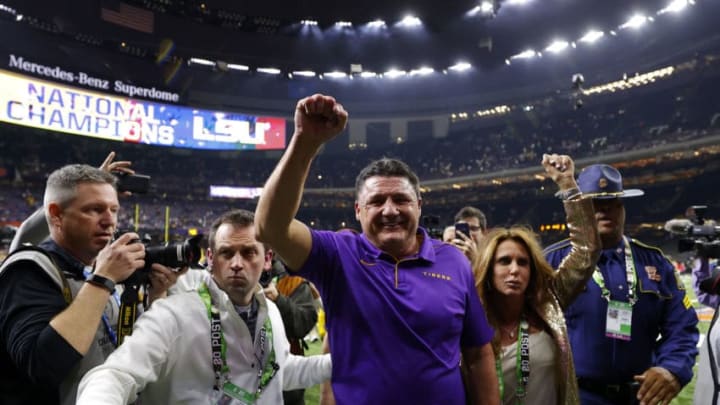LSU Football: Final report card from title-winning 2019 season
By Dante Pryor

Overall offense grade: A+
Outstanding performers
Joe Burrow: 76.3 percent completion percentage, 5,671 yards, 60 touchdowns six interceptions: Joe Burrow’s stats speak for themselves, but he had the greatest one year turn around of any player in the history of college football. His single-season numbers are career statistics for some quarterbacks.
Clyde Edwards-Helaire: 215 carries, 1,414 yards, 16 rushing touchdowns, 55 receptions, 453 yards and one touchdown: Clyde Edwards-Helaire was the unsung hero of the Tigers’ season. He was the go-to when the Tigers offense needed a first down. If it was third-and-five and the defense brought pressure it was Edwards-Helaire who slipped out the backfield and got eight yards to move the sticks.
Ja’Marr Chase: 84 receptions, 1,780 receiving yards, 21.2 yards per reception and 20 touchdowns: Ja’Marr Chase was the home run hitter for the Tigers. Even with a chain mover like Edwards-Helaire, down and distance never matter much with this offense because of Chase. It would be fascinating to know what the practices between him and Derek Stingley Jr. looked like.
Quarterback: A+
Burrow had arguably the greatest season in college football history. His single-season performance rivals the season Barry Sanders had in 1988 where he set the single-season rushing and touchdown record. There’s little doubt is was the greatest season by a quarterback if you factor the competition he played against and the type of offense he ran.
What’s most profound about the season Burrow had is he never had a bad game. Every weekend Burrow stepped on the field and dominated his opponents. There were some games where he needed a quarter or so to figure things out, but once he did it was pedal to the metal.
Running Back: A+
In an RPO style offense, the run game is supposed to be complementary. This complementary run game would make anyone blush. One of the many records the LSU Tigers set this season was having a 4,000-yard passer, two 1,000-yard receivers and a 1,000-yard rusher. Edwards-Helaire didn’t break the 1,000-yard mark by the skin of his teeth either. He ran for over 1,400 yards.
What made the running back position so great this season was Edwards-Helaire’s ability to be an every-down back. His more than six yards per carry proves he more than a capable runner. He’s adept at picking up the blitz as a blocker and is a polished route runner. The running game did more than keep defenses honest, it gave opposing defensive coordinators nightmares.
Wide Receiver/Tight End: A+
Any time you have two wide receivers that have over 1,000 yards receiving you are bound for an A, right? Not only did Justin Jefferson and Ja’Marr Chase have huge seasons, but Thaddeus Moss had a solid year at tight end and gave Clemson defensive coordinator Brent Venables fits in the National Championship Game.
Slot receiver Terrace Marshall Jr. had 13 touchdown receptions. A season like Burrow’s isn’t possible when you have receivers putting the ball on the turf, and the Tigers’ receivers did not do much, if any, of that.
Offensive Line: A+
The offensive line anchored this perfect offense. They were built to block for this type of offense. They set the tone, protected the quarterback, and paved the way for the running game. This record-setting season does not happen without one of the best offensive lines in the country.
Don’t let the fact the offensive line finished 86th in sacks allowed fool you. Burrow averaged over 10 yards per pass. Vertical passing games are prone to giving up more sacks because deep routes take time to develop. This was a solid group and the numbers prove that.